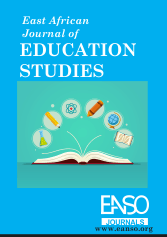Gender Stereotype in Tess of The D’urbervilles by Thomas Hardy and The Great Gatsby by F. Scott Fitzgerald
Abstract
This study focused on gender stereotypes in Thomas Hardy’s Tess of the D’Urbervilles (1891) and F. Scott Fitzgerald’s The Great Gatsby (1925). The objectives of the study were to: examine the portrayal of masculinity-femininity stereotype; examine the language used in gender stereotype and analyse the impact of traditional gender stereotype on the female characters. The study used the feminist theory to examine gender stereotype in the two male–authored novels to show how they have positioned and portrayed women in their literature in the Victorian period both in England and America The literary analysis was to ascertain whether or not the gender stereotype was a global notion in literature or a misrepresentation of the women not as persons but as sexualized figures. Gender stereotype in these novels was examined using the descriptive research design and data was collected using literary analysis. The findings indicated that both novels portrayed the female gender with discrimination, injustice, dishonesty and exploitatively. This was done with the use of symbolism, imagery, similes and metaphor. The conclusion drawn points to the fact that the quest for a masculine identity is a common theme as male characters are seen struggling to become real men with traits such as: power, strength and robustness whereas female characters were portrayed as sexualized figure used for social status in the male dominated societies. With regard to language stereotype, the male characters employed language to paint negative image in line with the accepted image in the male dominated society. The researchers recommend that detailed and comprehensive studies be conducted in the area of gender and culture and gender and literature in the novel as a genre generally
Downloads
References
Castagno-Dysart, D. (2016). ‘Gender Roles and Stereotypes Revealed in Recent Best Selling Adolescent Literature; Content Analysis. Retrieved October 11, 2020 from https//moSpace.umstem.edu/xmlui/bistream/handle/10355/59823/research.pd?sequence=2&isAllowed=y
Clark, R., Guilmain, J., Saucier, P. K., & Tavarez, J. (2003, Nov). Two steps forward, one step back: The presence of female characters and gender stereotyping in award-winning picture books between the 1930s and the 1960s. Sex Roles, 49(9/10), 439-449.
Copenhaver, B. (2002, May). A Portrayal of Gender and a Description of Gender Roles in Selected American Modern and Postmodern Plays. Retrieved August 17, 2020, from https://dc.etsu.edu/cgi/viewcontent.cgi?article=1789&context=etd
Copenhaver, B. (2002, May). A Portrayal of Gender and a Description of Gender Roles in Selected American Modern and Postmodern Plays. Retrieved October 11, 2020, from https://dc.etsu.edu/etd
Easley, A. (2015). Victorian Women Writers Careers (Part I)-The Cambridge Victorian Women's Writing. Cambridge University Press: Retrieved September 29, 2020, from https://www.cambridge.org
Fitzgerald, F. Scott. (2012 ed.). The Great Gatsby. Collins Classics. Harper Press: London
Giuliano, P. (2017). Discussion PaPer series Gender: An Historical Perspective. 10931. www.iza.org
Hardy, T. (1867). Thomas Hardy : Biography. 1878, 1–2.
Hardy, Thomas. (1983) Tess of the D’Urbervilles. Oxford World’s Classics. New York
Hentchel, T., Heilman, M. & Peus, C. V. (2019). The Multiple Dimensions of Gender Stereotypes: A Current Look at Men’s and Women’s Characterizations of Others and Themselves. Retrieved August 17, 2020, from https://www.frontiersin.org /articles/10.3389/fpsyg.2019.00011/full
Hentschel, T., Heilman, M., & Claudia, P. (2019). The Multiple Dimensions of Gender Stereotypes: A Current Look at Men’s and Women’s Characterizations of Others and Themselves. Personality and Social Psychology. doi:10.3389/fpsyg.2019.00011
Knoll, J. (2016, September 28). Studying Gender Roles in Literature and Life. Teaching Tolerance, Retrieved October 14, 2020, from https://www.tolerance.org /magazine/studying-gender-roles-in-literature-and-life
Koenig, A. M., & Eagly, A. H. (2014). Evidence for the social role theory of stereotype content: Observations of groups’ roles shape stereotypes. Journal of Personality and Social
Paynter, K.C. (2011). ‘Gender Stereotypes and Representation of Female Characters in Children’s Picture Books’. Retrieved October 11, 2020 from https//digitalcommons.liberty.edu/cgi/View.cgi?articles=1500&content=doctoral
Phillips, S. P. (2005, July 13). Defining and measuring gender: A social determinant of health whose time has come. International Journal for Equity in Health, 4. doi:https://doi.org/10.1186/1475-9276-4-11Psychology, 107(3), 371-392. doi: 10.1037/a0037215
Ramšak, A. (2017). Gender, Gender Concepts and Definitions. Manual for Trainers: Gender Equality and Gender Mainstreaming, 10–17.
Rennie, D. A. (2020). F. Scott Fitzgerald. American Writers and World War I, 104–133. https://doi.org/10.1093/oso/9780198858812.003.0006
Valackienė, Asta, Krašenkienė, Asta (2007), Diskriminacijos raiška ir valstybės institucijos bei visuomeninis sektorius, Filosofija. Sociologija, Vilnius: Lietuvos mokslų akademija, Nr. 2, pp. 33–43.
Weedon, C. (2012). Postcolonial feminist criticism. (P. Gill, Ed.) 282-300. Retrieved from doi.org/10.1017/CBO9781139167314.019
Copyright (c) 2024 Ketty Auma, Charles Nelson Okumu

This work is licensed under a Creative Commons Attribution 4.0 International License.




























